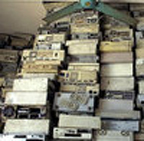
Waste from the manufacturing and distribution process
pollutes air and water many kilometers from the point of origin. Discarded
goods, along with original over-packaging, find their way to land fill sites,
either in the community or in some faraway land.
Old computers, cell phones and television sets go to Kenya, China and India
where they are dismantled for their lead, silver, cadmium, gold etc to feed the
developing industrial chain. The recycling process involving acid baths and
torches produce toxic fumes hazardous to the employees earning $2 to $4 a day.
Dangerous substances make ground water undrinkable. Consumer awareness of the
e-waste issue is growing and some companies are starting to listen.
Space too is cluttered with millions of pieces of debris from disintegrated
satellites endangering the world's communication and navigation systems. Some of
the pieces in low orbit will burn soon but those in higher orbit will remain for
hundreds of years.
“Space is not a big empty space” but a natural resource that
must be protected the same way we are learning to protect resources on Earth,
according to Geoffrey Forden, MIT physicist and expert on the Chinese space
program.
There are other kinds of toxic debris that can be a drag on our lives unless we
identify and replace them with new vision and energy.
These immobilizing debris are jealousy, guilt, dishonesty and negligence, to name a few. Because they are virtually invisible we have to “look” inside to decide whether we want to continue to feed them because they are our phony friends, or to conquer them with forces such as generosity, respect, harmony and thoughtfulness, and liberate ourselves from the dangers of these old debris.
To do this, we must be willing over time to honestly examine ourselves, where we came from and where we are going. Each piece of dangerous debris can then be an opportunity for learning to live a happier and more healthful life, remembering that any lasting change that happens in society begins within the human being.
And as we clean
our ‘inner environments’, so too can we cleanse the external with more effect.